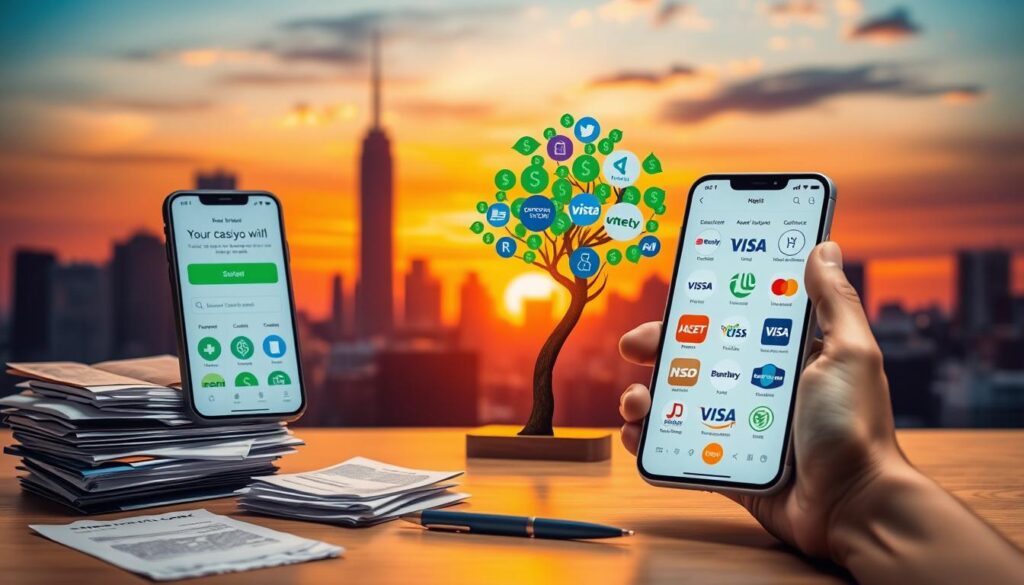Every time I opened my bank statement, a wave of anxiety would wash over me. The constant struggle of financial planning seemed like an impossible mountain to climb. But what if saving money didn’t have to feel like a punishment?
Financial management isn’t about cutting out all joy from your life. It’s about making smart choices that let you keep more of your hard-earned cash while still enjoying the things that matter most. Modern money management is an art of balance – preserving your lifestyle while building financial security.
This guide will show you 20 innovative strategies to save money without feeling like you’re sacrificing your quality of life. Whether you’re trying to build an emergency fund, plan for future goals, or simply want more breathing room in your budget, these practical tips will transform how you think about spending and saving.
Key Takeaways
- Saving money can be enjoyable and strategic
- Financial planning doesn’t require total lifestyle sacrifice
- Smart money management is about making informed choices
- Small changes can lead to significant financial improvements
- Creating a sustainable budget is possible for everyone
Understanding Smart Money Management Basics

Financial planning is key to reaching your money goals. Learning to budget and cut expenses needs a smart plan. This plan changes how you see money. It starts with learning basic rules to build a strong financial base.
Good money management isn’t about cutting back too much. It’s about making smart choices that match your future plans. With a solid plan, you can control your money and grow your wealth.
Setting Realistic Financial Goals
Setting real goals needs thought and honesty. First, think about what’s important to you:
- Short-term savings targets
- Debt elimination strategies
- Retirement planning
- Emergency fund development
Creating a Sustainable Budget Framework
The 50/30/20 rule is a simple yet strong way to plan your finances. It helps you split your income:
- 50% for essential needs
- 30% for personal wants
- 20% for savings and debt repayment
Tracking Your Spending Habits
Reducing expenses starts with knowing where your money goes. Use digital tools and apps to track your spending. Knowledge is power in managing your finances.
By using these strategies, you’ll have a better relationship with your money. This sets you up for long-term success and peace of mind.
How to Save Money on Everyday Purchases

Reducing daily expenses doesn’t mean you have to give up quality. By using smart saving strategies, you can spend less without feeling like you’re missing out. The trick is to know where to look and how to shop wisely.
Discount shopping is not just about finding the cheapest deals. It’s about getting the most value for your money. Start by learning a few easy ways to cut costs. These can change how you buy things.
- Compare prices across multiple retailers
- Use cashback apps and browser extensions
- Download store-specific discount applications
- Sign up for email newsletters with exclusive deals
Technology has made saving money easier than ever. Apps like Rakuten and Ibotta can give you cash back on things you already buy. Browser extensions like Honey can automatically apply coupons at checkout.
| Strategy | Potential Savings | Effort Level |
|---|---|---|
| Cashback Apps | 5-10% | Low |
| Price Comparison | 10-20% | Medium |
| Generic Brands | 25-50% | Low |
Generic brands often offer identical quality at a lower price. Don’t be afraid to try store-brand products, especially for everyday items. Your wallet will appreciate these simple tips.
Maximizing Cashback and Reward Programs

Smart shoppers know the secret to save money isn’t just about cutting expenses—it’s about making every dollar count. Cashback and reward programs are smart ways to save without giving up your lifestyle.
Today’s discount shopping goes beyond just coupons. Digital tools now help you earn money back on things you already buy.
Credit Card Rewards Optimization
Your credit card can be a powerful tool for saving money if used right. Here are some tips to get the most out of rewards:
- Choose cards that fit your spending habits
- Know how to use points for the best value
- Keep track of special bonus categories
- Always pay off your balance to avoid interest
Shopping Apps and Browser Extensions
Apps make finding discounts super easy. Platforms like Rakuten, Honey, and Ibotta give you cashback at many stores.
- Rakuten: Earn percentages back on online buys
- Honey: Finds and applies the best coupon codes for you
- Ibotta: Offers cashback on groceries and more
Store Loyalty Programs Worth Joining
Not all loyalty programs are the same. Look for ones that offer real rewards without needing you to spend a lot.
- Amazon Prime: Free shipping and special deals
- Target Circle: Personal discounts and birthday perks
- Walmart+: Save on groceries and get free delivery
Pro tip: Always read the fine print and understand each program’s specific terms to maximize your savings potential.
Smart Grocery Shopping Strategies
Reducing your grocery bills is a great way to save money and live more frugally. The average American family spends a lot on food each month. But, with smart shopping, you can cut down on these costs.
Begin by learning how to plan your meals. This approach helps you:
- Reduce food waste
- Minimize impulse purchases
- Purchase ingredients more strategically
- Lower your overall grocery budget
While shopping, use these budget-friendly tips:
- Shop with a detailed list
- Compare prices across different stores
- Use digital coupons and cashback apps
- Buy seasonal produce
- Purchase store-brand products
Cooking at home is another smart way to save. Preparing meals from scratch can cut food expenses by up to 50% compared to eating out. Simple recipes like rice bowls, stir-fries, and one-pot meals are both healthy and affordable.
Pro tip: Stock up on non-perishable items during sales. Also, consider buying in bulk for ingredients you use often. These strategies make grocery shopping a smart way to manage your money.
The Power of Second-Hand Shopping
Frugal living doesn’t mean you have to give up quality. Second-hand shopping lets you save money and find great items at low prices. You can save 50-90% on clothes, furniture, and electronics.
Choosing second-hand shopping is not just about saving money. It’s also good for the planet. It helps reduce waste and supports sustainable living.
Best Places for Quality Used Items
- Online marketplaces like Facebook Marketplace
- Local thrift stores
- Consignment shops
- Goodwill and Salvation Army
- Craigslist and eBay
What to Buy Used vs. New
Not everything should be bought second-hand. Here are some tips for saving money:
- Great for Used:
- Furniture
- Books
- Kitchen appliances
- Sporting equipment
- Musical instruments
- Better to Buy New:
- Mattresses
- Car seats
- Safety equipment
- Intimate apparel
Using Buy Nothing Groups Effectively
Community “Buy Nothing” groups on social media are full of free items. These groups help neighbors give away items they no longer need. This way, you can get things without spending money.
By using these second-hand shopping tips, you can change how you spend money. You’ll find many ways to save while being kind to the environment.
Subscription Audit: Cutting Unnecessary Expenses
Digital subscriptions can quietly take a big chunk out of your budget. Many people spend a lot of money each month on services they don’t really use. It’s important to do a subscription audit to cut down on expenses and manage your budget better.
First, make a list of all your current subscriptions. Look at your bank statements and credit card records to get a complete list. This is key to finding out where your money is going and cutting costs.
- Review streaming services
- Check software subscriptions
- Examine meal delivery plans
- Investigate digital magazine/news memberships
- Audit fitness and wellness apps
Then, rate each subscription based on how often you use it, its value, and if it fits your lifestyle and financial goals. Use a simple scoring system for this.
| Subscription Type | Monthly Cost | Usage Frequency | Keep/Cancel |
|---|---|---|---|
| Netflix | $15.49 | Daily | Keep |
| Spotify Premium | $9.99 | Weekly | Keep |
| Unused Workout App | $12.99 | Never | Cancel |
Think about rotating your subscriptions, like streaming services. Instead of having many subscriptions at once, switch them out monthly. This can help you save money and still enjoy different content.
Also, use free trials and special offers wisely. Many services offer low rates or bundles at first. These can help you save money without losing quality.
Quality Over Quantity: Investment Purchases
Smart money management is not about spending the least. It’s about spending wisely. Understanding the difference between cheap and valuable investments is key.
When saving, look for items that last long and offer great value. Not every expensive item is a waste. Some can actually save you money over time.
Identifying Long-term Value Items
Look for products with these key characteristics:
- High-quality materials
- Excellent craftsmanship
- Proven durability
- Comprehensive warranty
When to Spend More to Save Later
Strategic spending means investing in items that save you money later. Here are some scenarios where spending more upfront is wise:
- Appliances with high energy efficiency
- Reliable transportation with low maintenance costs
- Professional-grade tools that last decades
- Comfortable, well-constructed shoes and clothing
Maintenance Tips for Lasting Value
Take care of your investments with regular maintenance. Preventative maintenance can make an expensive item cost-effective over time.
Your money management should focus on quality, functionality, and longevity. Being selective and strategic helps you build reliable possessions that last for years.
DIY and Home Economics Solutions
Learning DIY skills is a great way to save money at home. By fixing things yourself, making your own products, and doing personal care, you can save a lot. Start with simple tasks and grow your skills over time.
Home economics can help you save money without needing to be an expert. You can cut costs by learning to do things yourself instead of hiring professionals or buying expensive products.
- Basic home repair skills like painting and simple plumbing
- Creating homemade cleaning solutions
- Learning basic sewing and clothing repair
- Preparing meals from scratch
- Generating household products at home
Begin your DIY adventure by checking out free online resources. YouTube, community workshops, and local library classes are great places to learn new skills without spending a dime.
| DIY Skill | Potential Annual Savings |
|---|---|
| Basic Home Repairs | $500 – $1,500 |
| Homemade Cleaning Products | $200 – $400 |
| Personal Care DIY | $300 – $600 |
Pro tip: Start with simple projects and gradually build confidence in your DIY abilities. The joy of making something yourself is more than just saving money. It also makes you more self-reliant and skilled in everyday life.
Free Entertainment and Social Activities
Living frugally doesn’t mean you can’t have fun. Many cities offer free activities that help you save money. You can enjoy a vibrant social life without spending a lot.
Local Free Events and Resources
Your local community has lots of free entertainment. Libraries, community centers, and websites list free events. Here are some great resources:
- Library book clubs and reading events
- Free museum days
- Community art exhibitions
- Local park concerts
- Public lectures and workshops
Community-Based Activities
Getting involved in your neighborhood can be rewarding and save you money. Here are some ideas:
- Join community sports leagues
- Participate in volunteer organizations
- Attend neighborhood meetups
- Join local hobby groups
Nature-Based Recreation Options
Nature is a great place to find free fun. Outdoor activities are good for your body and mind. And they’re free:
- Hiking local trails
- Beach or park picnics
- Community gardening
- Bird watching
- Free outdoor fitness classes
By trying these free activities, you can stay active and social. And you’ll be practicing smart money habits too.
Automated Savings Techniques
Changing your financial planning doesn’t have to be hard. Automated savings strategies are a great way to grow your wealth easily. They help you manage your money better and build a strong financial future.
Use technology to make saving money simple with these effective methods:
- Set up automatic bank transfers to your savings account
- Use round-up apps that save spare change automatically
- Enroll in employer-sponsored retirement plans
- Create scheduled transfers on payday
Your bank probably has tools to make saving easier. Payroll deductions can send a part of your income to savings before you even get it. This way, you avoid spending it and keep growing your finances steadily.
Digital apps and banking sites now make saving easy. Some apps look at how you spend money and save a little for you. This helps you build savings without feeling it too much.
Pro tip: Begin with small steps in automation. Saving 5-10% of your income can lead to big wealth over time. As you get more comfortable, increase how much you save to reach your financial goals faster.
The 24-Hour Purchase Rule and Mindful Spending
Learning to manage money isn’t about giving up all fun. It’s about making choices that help you reach your goals. The 24-hour purchase rule is a great way to spend less and think more about your spending.
This rule helps you pause before buying something. If you see something you want, wait 24 hours before buying it. This pause lets you think if the item is really worth it.
Implementation Strategies
To use the 24-hour rule, you need discipline and a plan. Here are some ways to make it work:
- Keep a wishlist on your phone or notebook
- Take a screenshot or note the item’s details
- Set a reminder to review the item after 24 hours
- Ask yourself critical questions about the purchase
Breaking Impulse Shopping Habits
Impulse buying often comes from emotions. Recognize your spending patterns and what makes you buy things. Are you shopping because you’re bored, stressed, or really need it?
Building Financial Discipline
The 24-hour rule is more than a budgeting trick. It’s a change in how you think about money. By using this rule, you’ll get better at controlling your spending and making smarter choices.
Remember, being financially disciplined isn’t about saying no to everything. It’s about giving yourself the power to choose what’s best for your money and future goals.
Conclusion
Saving money doesn’t mean you have to live a limited life. By planning your finances well, you can change how you spend money and build wealth. This guide shows that living frugally can be fun and empowering.
Every small step towards better money management adds up. Using cashback, checking subscriptions, or buying mindfully are all good ways to start. These actions help make your financial base stronger. Remember, it’s the consistent effort that counts, not being perfect.
Your path to saving money is your own. Begin with one or two strategies that fit your life. As you get more comfortable, add more techniques. The goal is to make steady, lasting improvements that match your goals and values.
With dedication and the right approach, you can build strong financial habits. These habits will give you security and peace of mind. Stay patient with yourself, and watch your financial health grow. Your future self will thank you for the smart choices you make now.

